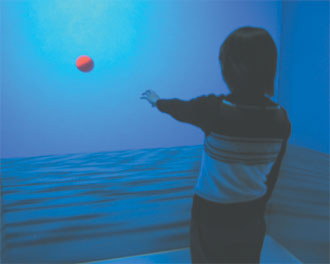
 |

|
YANO Sumio Department of Vision Dynamics Human Information Science Laboratories * |
|
| 1. Introduction
Our development of communication technology related to the human visual system takes two approaches: visual perception and visual production. Once we understand the mechanisms of visual perception, we can feed the findings back to a visual production system designed to conform to our visual system. In turn, new technologies for visual production can be used to explore models of visual perception. In this article, two topics are described: 1) Analysis of our visual perception of moving objects and applications of the results to sports training and rehabilitation, and 2) Exploration of face-to-face communication using talking-head technology. 2. Visual prediction of moving objects |
||
 Fig. 1. Experiment on visual prediction using a wide-field stereoscopic display. |
|
The catching of a moving object is considered one of the important factors in sports training, which generally comprises training of both vision and motor control functions. We found that the visual prediction function utilized for a moving object is improved by practice with the human vision system alone. Furthermore, we found that prediction accuracy for a moving object not only improves, but that prediction confidence is also increased [2]. An effective practice method for improving visual prediction ability is investigated with respect to effective virtual image display methods, learning methods and identification of the localized part of the brain related to visual prediction. We plan to develop a new visual presentation system by continuing this research, and we will utilize the research results to develop effective sports training and rehabilitation systems, which will play an important role in the future aging society. 3. The role of facial information in personal communication |
|
|
|
We also developed a talking-head animation system as a tool for synthesizing a life-like face. We began our investigation with visual perception of exaggerated emotional facial expressions, exaggerated smiles and so on using this software tool. Figure 3 shows the principle method of synthesis of the talking-head animation. First, the three-dimensional shape data for the face and the auditory speech data are acquired. Second, for the face image, mesh data is adapted and principle component analysis (PCA) is conducted. Finally, certain components of the PCA are linearly combined based on the auditory speech data. This face animation, which is similar to the subject's facial expressions and speech behavior, is synthesized using these processes [4]. Therefore, even if the face is that of a cat or comic book hero, if the three-dimensional data exist, it can be driven by auditory speech and motion-capture data. We have been developing a talking-head animation system that can be applied to any person utilizing a three-dimensional shape database of the faces of several hundred subjects. The role of facial information in personal communication is investigated using computer software that allows manipulation of facial motion with complete control. This research is connected to the development of a natural interactive interface for human communication.
|
|
|
|
4. Conclusion References * YANO Sumio is currently at NHK Science & Technical Research Laboratories |